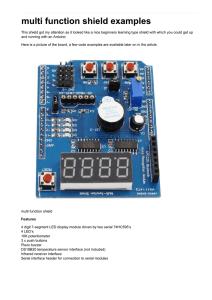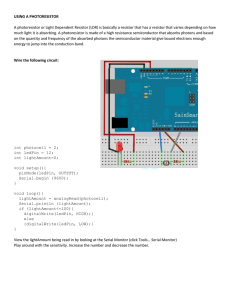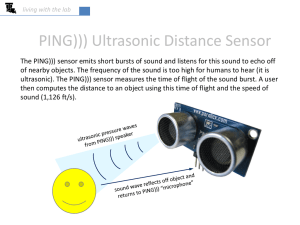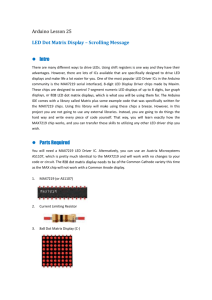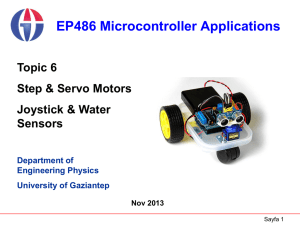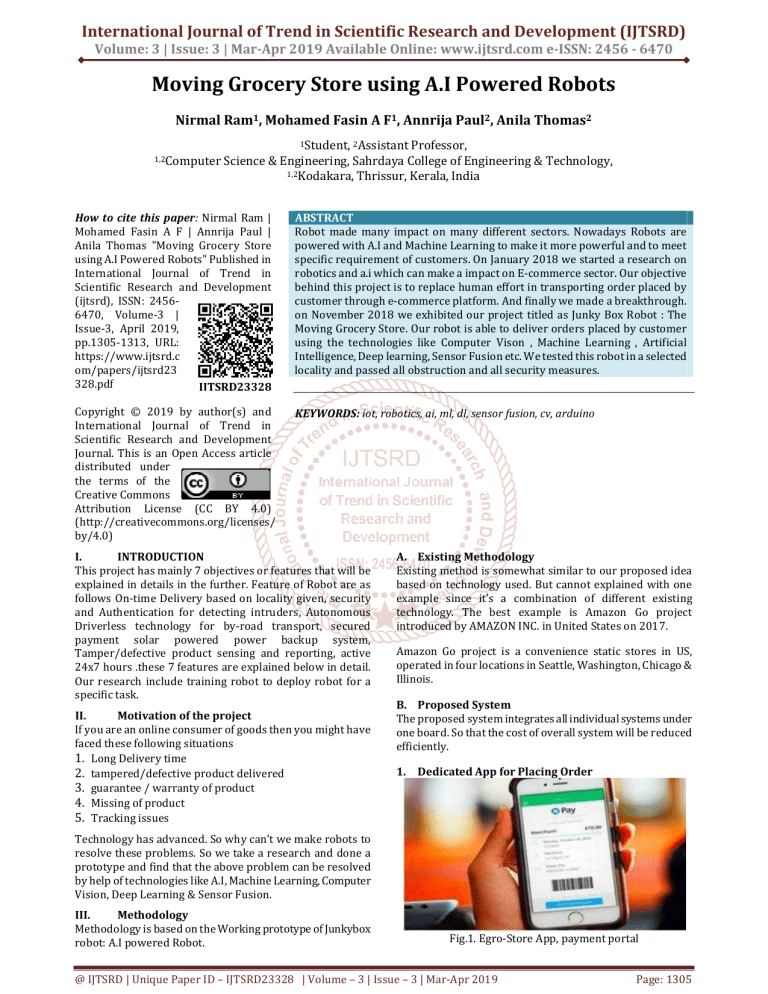
International Journal of Trend in Scientific Research and Development (IJTSRD)
Volume: 3 | Issue: 3 | Mar-Apr 2019 Available Online: www.ijtsrd.com e-ISSN: 2456 - 6470
Moving Grocery Store using A.I Powered Robots
Nirmal Ram1, Mohamed Fasin A F1, Annrija Paul2, Anila Thomas2
1,2Computer
1Student, 2Assistant Professor,
Science & Engineering, Sahrdaya College of Engineering & Technology,
1,2Kodakara, Thrissur, Kerala, India
How to cite this paper: Nirmal Ram |
Mohamed Fasin A F | Annrija Paul |
Anila Thomas "Moving Grocery Store
using A.I Powered Robots" Published in
International Journal of Trend in
Scientific Research and Development
(ijtsrd), ISSN: 24566470, Volume-3 |
Issue-3, April 2019,
pp.1305-1313, URL:
https://www.ijtsrd.c
om/papers/ijtsrd23
328.pdf
IJTSRD23328
ABSTRACT
Robot made many impact on many different sectors. Nowadays Robots are
powered with A.I and Machine Learning to make it more powerful and to meet
specific requirement of customers. On January 2018 we started a research on
robotics and a.i which can make a impact on E-commerce sector. Our objective
behind this project is to replace human effort in transporting order placed by
customer through e-commerce platform. And finally we made a breakthrough.
on November 2018 we exhibited our project titled as Junky Box Robot : The
Moving Grocery Store. Our robot is able to deliver orders placed by customer
using the technologies like Computer Vison , Machine Learning , Artificial
Intelligence, Deep learning, Sensor Fusion etc. We tested this robot in a selected
locality and passed all obstruction and all security measures.
Copyright © 2019 by author(s) and
International Journal of Trend in
Scientific Research and Development
Journal. This is an Open Access article
distributed under
the terms of the
Creative Commons
Attribution License (CC BY 4.0)
(http://creativecommons.org/licenses/
by/4.0)
KEYWORDS: iot, robotics, ai, ml, dl, sensor fusion, cv, arduino
I.
INTRODUCTION
This project has mainly 7 objectives or features that will be
explained in details in the further. Feature of Robot are as
follows On-time Delivery based on locality given, security
and Authentication for detecting intruders, Autonomous
Driverless technology for by-road transport, secured
payment solar powered power backup system,
Tamper/defective product sensing and reporting, active
24x7 hours .these 7 features are explained below in detail.
Our research include training robot to deploy robot for a
specific task.
II.
Motivation of the project
If you are an online consumer of goods then you might have
faced these following situations
1. Long Delivery time
2. tampered/defective product delivered
3. guarantee / warranty of product
4. Missing of product
5. Tracking issues
A. Existing Methodology
Existing method is somewhat similar to our proposed idea
based on technology used. But cannot explained with one
example since it’s a combination of different existing
technology. The best example is Amazon Go project
introduced by AMAZON INC. in United States on 2017.
Amazon Go project is a convenience static stores in US,
operated in four locations in Seattle, Washington, Chicago &
Illinois.
B. Proposed System
The proposed system integrates all individual systems under
one board. So that the cost of overall system will be reduced
efficiently.
1. Dedicated App for Placing Order
Technology has advanced. So why can’t we make robots to
resolve these problems. So we take a research and done a
prototype and find that the above problem can be resolved
by help of technologies like A.I, Machine Learning, Computer
Vision, Deep Learning & Sensor Fusion.
III.
Methodology
Methodology is based on the Working prototype of Junkybox
robot: A.I powered Robot.
Fig.1. Egro-Store App, payment portal
@ IJTSRD | Unique Paper ID – IJTSRD23328 | Volume – 3 | Issue – 3 | Mar-Apr 2019
Page: 1305
International Journal of Trend in Scientific Research and Development (IJTSRD) @ www.ijtsrd.com eISSN: 2456-6470
We have a dedicated app in which the order can be added to
cart. Payment can be done both prepaid and post-paid via
any online wallet. Moreover app have many other features
like showing the existing stoke of product and also finding an
ideal Junky box robot nearby for fast delivery (like uber or
Ola Taxi concept)
5. Virtual control
2. Autonomous Driverless Moving System
Fig.5. Virtual Monitor & Controller
In India Autonomous car is not feasible so that as an existing
solution we found out to be is control virtually from base
station to clients location safely. (Service available only in
selected locations)
6. Inbuilt gas sensors & storing unit for food products
Fig.2. Architecture of Junky box Wheel control
We have a specially designed Moving part attached to the
bottom part of our Robot which help it to move across all
terrains.
Also included many safety features like ABS and Pedestrian
& Signal Detection also have manual mode (When Autopilot
Mode Off) using power of A.I and CV
3. User Authentication
Fig.6. Fresh Food products
Using Technologies like Deep Learning, machine Learning &
Sensor Fusion, Robot is able to distinguish between
products. Basically food products need special care so the
cabin is designed with sensors. So based on sensor value the
robot is able to control cooling/ heating mechanism to keep
the food fresh during journey. Or give an insight/alert for
company when food is not able to deliver as fresh.
7. Secured Payment Gateway
Fig.3. QR code Authentication
Fig.7. Secured Payment Gateway
Using Technologies like CV & Deep Learning the Robot is
able to distinguish its user from other non-users. Also can be
used at the time of emergency.
Payment Gateway is Encrypted and Secured from all kind of
threat. Use concept of Bit-Coin/ Block chain technology.
4. Solar Powered
C. Procedure Flow
Fig.4. Solar cell of Junky box
Powered with solar so that robot can work throughout day &
night with battery backup technology during night period.
Fig.8. Working Principle of Junky box Robot
@ IJTSRD | Unique Paper ID - IJTSRD23328 | Volume – 3 | Issue – 3 | Mar-Apr 2019
Page: 1306
International Journal of Trend in Scientific Research and Development (IJTSRD) @ www.ijtsrd.com eISSN: 2456-6470
At first, the customer have to scan the QR-code which will
redirect to create an account in the online shopping website
page if he/she doesn’t have an account (more efficient way)
then, After creating an account, a user-authentication QRcode is Generated. The front-part of Junky box lies Camera
sensor powered with computer vision technology and once
the QR-code (Generated) is shown to the camera, the camera
will immediately detects the QR-code and authenticate with
its database corresponding to the account created. Once this
step is completed the customer is able to shop within its
limit. So what all things you taken or choose from the store
will be automatically added to your Checkout cart in online
website and payment can be made using your Card or any
other online wallets you have.
1. Using Technologies like computer vision and deep
learning enhance and improve the existing shopping
experience.
2. Using Artificial Intelligence Robot will be able to sell like
a shopkeeper trying to sell its product.
3. Work 24 x 7 efficiently without any delays or tired.
4. Also helpful in transporting goods to one store to
another.
5. Using its Deep Learning algorithm understand the
crowded area where selling items is legal and profitable.
IV.
Components
Following are the components used for prototyping our
project.
LED's are very handy for all sorts of lighting. And its very
power efficient and easy for circuitry works.
D. SR-04 Ultrasonic Sensors
Fig.12. SR-04 Ultrasonic Sensor
It’s useful to detect the obstacles in front to avoid hitting. It
also allows to analyse the distance between the obstacle and
the body.
E. Stepper motor
Fig.13. Stepper Motor
For ready motion we need stepper motors for the job to be
done.
F. Camera modules
A. Arduino UNO Dev. Board
Fig.9 Arduino UNO Dev. Board (source: google.com)
As Arduino UNO is an open-source development board it
also have an IDE, a community for the support. It also easy to
design projects with it since it has at-mega.
B. SG-90 Servo Motors
Fig.14. Web Camera Module
If there's a need of security we rely on cameras, it analyses
every sides and reports thefts to the company. Also helps in
avoiding hitting to obstacles nearby. Image recognition helps
in identifying people and other objects for easy reach to the
customers.
G. Gas sensors
Fig.15. Gas sensor
Fig.10. SG-90 Servo Motors
Servo motors are handy when you need simple rotatory
motions. SG-90 is very lightweight and compact servos
which helps in movement of our prototype parts.
We need gas sensors to detect harmful gases in the food
products that helps in delivering fresh foods to the
customers. Also to analyse decaying of food in near future.
H. ESP8266 NodeMCU 12e
C. LED
Fig.11. Light emitting Diode
Fig.16. esp8266 nodemcu 12e
@ IJTSRD | Unique Paper ID - IJTSRD23328 | Volume – 3 | Issue – 3 | Mar-Apr 2019
Page: 1307
International Journal of Trend in Scientific Research and Development (IJTSRD) @ www.ijtsrd.com eISSN: 2456-6470
Node MCU is the common name for this board helps in
controlling
Serial.begin(9600);
}
The product wireless, it’s also a development board like
Arduino UNO but its very lightweight and compact than
Arduino.
void servoup()
{
I. L298N motor Shield
servo1.write(45); // initial down stage servo2.write(65);
//initial down stage Serial.println("\n\n Access Granted .
Pickup your items from cart . Happy shopping !");
}
void servodown()
Fig.17. L298N Motor Shield
{
We need a driver for controlling the movement of wheels of
the robotic car, then we found out the best driver for it.
servo1.write(110); //fixed up stage servo2.write(0); //fixed
up stage Serial.println("\n\n The Door is Locked . Scan
QRcode to Proceed . ");
V.
Programming
A. Junkybox_box_code.ino
}
void internalsensor()
/* licenced by pineapplem3 Inc. This program is used for
Junkybox any reproduction of this code is strictly prohibited.
Compiled and developed by : Nirmal Ram
{
delay(1000);
*/
digitalWrite(8, LOW);
#include <Servo.h>
delayMicroseconds(2);
Servo servo1; // any name can be choosen in case of "
myservo" Servo servo2;
digitalWrite(8, HIGH);
int internallimit = 12 , externallimit = 5; void setup() {
delayMicroseconds(5); // will send waves of 2 ms low wave
& 5 ms high wave
pinMode(12, OUTPUT);
// buzzer alert
long x1 = pulseIn(9, HIGH);
pinMode(6, OUTPUT);
// Redlight
pinMode(7, OUTPUT);
//greenlight
pinMode(5, OUTPUT);
//bluelight
pinMode(3, OUTPUT);
// triggger is
// echo is input
// triggger is
of internal sensor
servo1.attach(10);
servo2.attach(2);
void externalsensor()
//delay(1000);
digitalWrite(3, LOW);
output of internal sensor
pinMode(9, INPUT);
Serial.println(internalsensor);
{
of external sensor
pinMode(8, OUTPUT);
= ");
}
output of external sensor
pinMode(4, INPUT);
int internalsensor = x1 / (29 * 2); Serial.print(" \nInternal
sensor detected
// echo is input
delayMicroseconds(2);
digitalWrite(3, HIGH);
delayMicroseconds(5); // will send waves of 2 ms low wave
& 5 ms high wave
long x2 = pulseIn(4, HIGH);
@ IJTSRD | Unique Paper ID - IJTSRD23328 | Volume – 3 | Issue – 3 | Mar-Apr 2019
Page: 1308
International Journal of Trend in Scientific Research and Development (IJTSRD) @ www.ijtsrd.com eISSN: 2456-6470
int externalsensor = x2 / (29 * 2);
}
//Serial.print(" \nExternal sensor
void greenlightoff()
detected = ");
{
Serial.println(externalsensor);
digitalWrite(7, LOW); // turn off green light
Serial.print("\n\n Green Light is
}
deactivated");
void redlighton()
}
{
void alert()
// Turn On Buzzer & LEDS
digitalWrite(6, HIGH); // turn on red Light Serial.print("
\n\n Red Light is activated");
Blink Circuit
}
{
void redlightoff()
Serial.print("\n\n Warning...Something Wrong. Securing
Vault . Doors Locked"); digitalWrite(12, HIGH);
digitalWrite(7, HIGH); digitalWrite(6, HIGH); digitalWrite(5,
HIGH);
{
digitalWrite(6, LOW); // turn off red light
delay(50);
Serial.print(" \n\n Red Light is
digitalWrite(12, LOW);
deactivated");
digitalWrite(7, LOW);
}
digitalWrite(6, LOW);
void bluelighton()
digitalWrite(5, LOW);
{
delay(50);
digitalWrite(5, HIGH); // turn on blue Light
}
Serial.print(" \n\n Blue Light is
void buzzer()
// barcode reading sound
activated");
{
}
digitalWrite(12, HIGH);
void bluelightoff()
delay(50);
{
digitalWrite(12, LOW);
digitalWrite(5, LOW); // turn off blue light
delay(50);
Serial.print("\n\n Blue Light is
deactivated");
Serial.print("\n\n BarCode Detected. Authentication Success.
Database Updated......(100%)"); }
}
void greenlighton()
void loop() {
{
servodown();
digitalWrite(7, HIGH); // turn on green Light
externalsensor();
Serial.print("\n\n Green Light is
internalsensor();
activated");
delay(1000);
@ IJTSRD | Unique Paper ID - IJTSRD23328 | Volume – 3 | Issue – 3 | Mar-Apr 2019
Page: 1309
International Journal of Trend in Scientific Research and Development (IJTSRD) @ www.ijtsrd.com eISSN: 2456-6470
redlighton();
if (internalsensor <= internallimit)
digitalWrite(3, LOW);
{
delayMicroseconds(2);
count--;
digitalWrite(3, HIGH);
buzzer();
delayMicroseconds(5); // will send waves of 2 ms low wave
& 5 ms high wave
}
}
long x2 = pulseIn(4, HIGH);
bluelightoff();
int externalsensor = x2 / (29 * 2);
delay(1500);
//Serial.print(" \nExternal sensor
servodown();
detected = ");
greenlightoff();
Serial.println(externalsensor);
delay(1000);
if (externalsensor <= externallimit)
}
{
else {
redlightoff();
digitalWrite(8, LOW);
buzzer();
delayMicroseconds(2);
greenlighton();
digitalWrite(8, HIGH);
servoup();
delayMicroseconds(5); // will send waves of 2 ms low wave
& 5 ms high wave
int count = 4;
long x1 = pulseIn(9, HIGH);
int i=0;
while(i<=count)
int internalsensor = x1 / (29 * 2); Serial.print(" \nInternal
sensor detected
{
= ");
internalsensor();
Serial.println(internalsensor);
delay(1000);
if (internalsensor <= internallimit)
digitalWrite(8, LOW);
{
delayMicroseconds(2);
while(1){
digitalWrite(8, HIGH);
alert();
delayMicroseconds(5); // will send waves of 2 ms low wave
& 5 ms high wave
}
}
long x1 = pulseIn(9, HIGH);
}
int internalsensor = x1 / (29 * 2); Serial.print(" \nInternal
sensor
}
detected = ");
Serial.println(internalsensor);
B. Junkybox_wheel_code.ino
bluelighton();
int trigger = 3;
@ IJTSRD | Unique Paper ID - IJTSRD23328 | Volume – 3 | Issue – 3 | Mar-Apr 2019
Page: 1310
International Journal of Trend in Scientific Research and Development (IJTSRD) @ www.ijtsrd.com eISSN: 2456-6470
digitalWrite(RMP, LOW); digitalWrite(RMN, HIGH);
digitalWrite(LMP, LOW); digitalWrite(LMN, HIGH);
int echo = 2;
int RMP = 10, RMN = 11, LMP = 7, LMN = 6;
}
void setup() {
void forward()
pinMode(trigger, OUTPUT);
// triggger
{
is output
Serial.println("moving forward for 5
pinMode(echo, INPUT);
// echo is
second" );
input
Serial.println("bluetooth working");
pinMode(RMP, OUTPUT);
pinMode(RMN, OUTPUT);
//LEFT
MOTION
digitalWrite(RMP,
digitalWrite(RMN, LOW); digitalWrite(LMP,
digitalWrite(LMN, LOW);
HIGH);
HIGH);
pinMode(LMN, OUTPUT);
}
pinMode(LMP, OUTPUT);
void stopme()
pinMode(5, OUTPUT);
{
pinMode(4, OUTPUT);
Serial.begin(9600);
Serial.println("stop command" ); digitalWrite(RMP, LOW);
digitalWrite(RMN, LOW); digitalWrite(LMP, LOW);
digitalWrite(LMN, LOW);
}
}
void left() {
void loop()
Serial.println("moving left for 5 second" );
{
Serial.println("bluetooth working"); digitalWrite(RMP,
HIGH); digitalWrite(RMN, LOW); digitalWrite(LMP, LOW);
digitalWrite(LMN, HIGH);
}
digitalWrite(trigger,
LOW);
digitalWrite(trigger, HIGH);
delayMicroseconds(2);
delayMicroseconds(5); // will send waves of 2 ms low wave
& 5 ms high wave
void right() {
long x = pulseIn(echo, HIGH);
Serial.println("moving Right for 5
int y = x / (29 * 2);
second" );
Serial.print(" cm ");
Serial.println("bluetooth working");
Serial.println(y);
digitalWrite(RMP, LOW);
delay(1000);
digitalWrite(RMN, HIGH);
if (y < 60) {
digitalWrite(LMP, HIGH);
digitalWrite(5, HIGH);
digitalWrite(LMN, LOW);
digitalWrite(4, HIGH);
}
stopme();
void backward() {
}
Serial.println("moving Backwards for 5
if (Serial.available())
second" );
{
//RIGHT MOTION
char c = Serial.read();
@ IJTSRD | Unique Paper ID - IJTSRD23328 | Volume – 3 | Issue – 3 | Mar-Apr 2019
Page: 1311
International Journal of Trend in Scientific Research and Development (IJTSRD) @ www.ijtsrd.com eISSN: 2456-6470
if (c == 'l' || c == 'L')
delay(1000);
{
if (y < 60) {
digitalWrite(trigger,
LOW);
digitalWrite(trigger, HIGH);
delayMicroseconds(2);
digitalWrite(5, HIGH);
delayMicroseconds(5); // will send waves of 2 ms low wave
& 5 ms high wave
digitalWrite(4, HIGH);
stopme();
long x = pulseIn(echo, HIGH);
delay(500);
int y = x / (29 * 2);
backward();
Serial.print(" cm ");
delay(2000);
Serial.println(y);
}
delay(1000);
else {
if (y < 60) {
right();
digitalWrite(5, HIGH);
digitalWrite(5, LOW);
digitalWrite(4, HIGH);
digitalWrite(4, LOW);
stopme();
}
delay(500);
}
backward();
delay(2000);
else if (c == 'F' || c == 'f')
}
{
else {
digitalWrite(trigger,
LOW);
digitalWrite(trigger, HIGH);
left();
delayMicroseconds(2);
delayMicroseconds(5); // will send waves of 2 ms low wave
& 5 ms high wave
digitalWrite(5, LOW);
digitalWrite(4, LOW);
long x = pulseIn(echo, HIGH);
}
int y = x / (29 * 2);
}
Serial.print(" cm ");
else if (c == 'r' || c == 'R')
Serial.println(y);
{
delay(1000);
digitalWrite(trigger,
LOW);
digitalWrite(trigger, HIGH);
delayMicroseconds(2);
if (y < 60) {
digitalWrite(5, HIGH);
delayMicroseconds(5); // will send waves of 2 ms low wave
& 5 ms high wave
digitalWrite(4, HIGH);
long x = pulseIn(echo, HIGH);
stopme();
int y = x / (29 * 2);
delay(500);
Serial.print(" cm ");
backward();
Serial.println(y);
delay(2000);
@ IJTSRD | Unique Paper ID - IJTSRD23328 | Volume – 3 | Issue – 3 | Mar-Apr 2019
Page: 1312
International Journal of Trend in Scientific Research and Development (IJTSRD) @ www.ijtsrd.com eISSN: 2456-6470
VI.
Outcome expected
1. Able to Deliver a Product based on the location of
customer.
2. Security Measures
3. Autonomous driverless movement
4. Virtual Control & Insights
5. Authenticate user
6. Fraud detection
7. Able to keep Food Product Fresh
8. Power Backup
}
else {
forward();
digitalWrite(5, LOW);
digitalWrite(4, LOW);
}
}
else if (c == 'b' || c == 'B')
{
digitalWrite(trigger,
LOW);
digitalWrite(trigger, HIGH);
delayMicroseconds(2);
delayMicroseconds(5); // will send waves of 2 ms low wave
& 5 ms high wave
long x = pulseIn(echo, HIGH);
VII.
Acknowledgment
This is an opportunity to express my sincere gratitude to all.
At the very outset, we express our thanks to the almighty
god for all the blessings endowed on us. The report is
submitted in regard with the project done as a part of the
fourth semester curriculum, we acknowledge our Sahrdaya
College of engineering and technology for giving us the
opportunity to do our project.
We would like to thank Executive Director Fr. George
Pareman, Principal Dr. Nixon Kuruvila, for providing us with
such great opportunity. We express our whole hearted
gratitude to Prof. Krishnadas J, H.O.D. of Computer Science
and Engineering department who has a source of constant
inspiration and suggestions throughout the project work.
int y = x / (29 * 2);
Serial.print(" cm ");
Serial.println(y);
delay(1000);
if (y < 60) {
digitalWrite(5, HIGH);
digitalWrite(4, HIGH);
stopme();
delay(500);
backward();
delay(2000);
}
else {
backward();
digitalWrite(5, LOW);
digitalWrite(4, LOW);
}
}
else if (c == 'S' || c == 's')
{
stopme();
}
}
}
We extend our sincere gratitude to our project coordinator,
Asst. Prof. Mrs. Anila Thomas for leading the way for the
completion of the project and would also like to thank our
project guide Mrs. Ann Rija Paul, for help and support. We
would also like to extend our appreciation to all other faculty
members for their help and advices.
REFERENCES
[1] G. Abinaya | K. Sridevi Nattar | Dr. Rajini Girinath
"Anticipation of Forged Video Evidence using Machine
Learning" Published in International Journal of Trend in
Scientific Research and Development (ijtsrd), ISSN:
2456-6470, Volume-2 | Issue-3 , April 2018, pp.14291433,
[2] J. Ackermann, D. Odenthal, T. Bnte, "Advantages of
active steering for vehicle dynamics control", Proc.
32nd Int. Symp. Autom. Technol. Autom., pp. 263-270,
1999.
[3] C. Oh, J.-S. Oh, and S. Ritchie, "Real-time hazardous
traffic condition warning system: framework and
evaluation," Intelligent Transportation Systems, IEEE
Transactions on, vol. 6, no. 3, pp. 265-272, Sept 2005.
[4] Dalal N, Triggs B (2005) Histograms of oriented
gradients for human detection. In: Computer Vision and
[5] Pattern Recognition, 2005. CVPR 2005. IEEE Computer
Society Conference On. IEEE Vol. 1. pp 886–893
[6] www.arduino.cc
[7] scholar.google.com
[8] www.instructables.com
[9] pineapplem3.com/junky box-robot/
@ IJTSRD | Unique Paper ID - IJTSRD23328 | Volume – 3 | Issue – 3 | Mar-Apr 2019
Page: 1313
